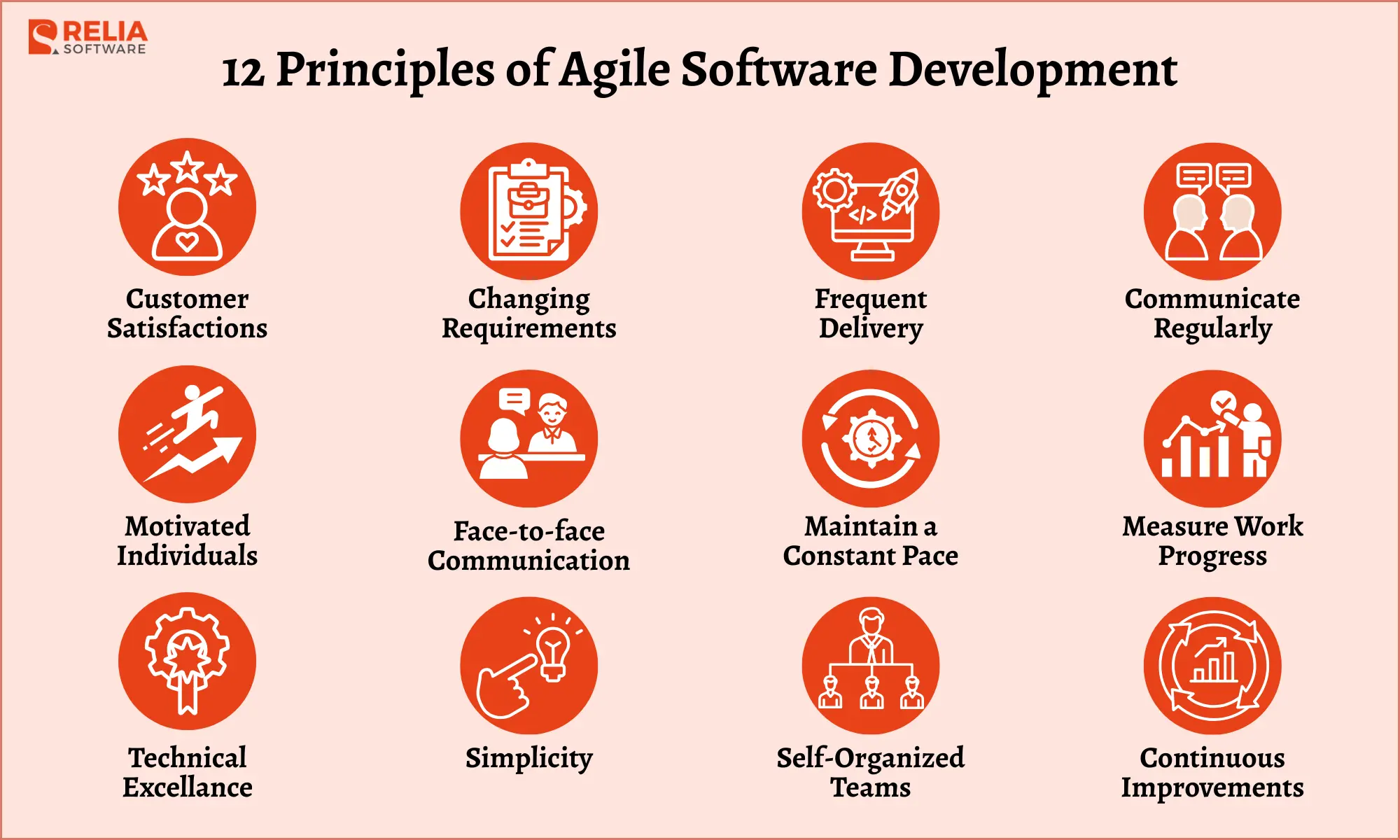Businesses' demands change quickly, just like technology does. Software teams can't use strict approaches that take months or years to get outcomes anymore. Instead, they need methods that help them change quickly, respond to continuous feedback, and get working solutions out more swiftly.
The Agile software development methodology was created to solve these speed problems and meet evolving requirements. Agile is both a process and a mindset that focuses on being flexible, working together, and delivering software in small, useful pieces.
In this blog, we’ll talk about what Agile is, its core values and principles, the software development lifecycle it follows, its benefits and challenges, and how it compares to traditional methods like the Waterfall model.
What Is Agile Software Development?
Agile Software Development refers to a software development methodology that uses short, iterative cycles to build and deploy software. Agile teams don't wait until the end of a long project to release usable features. They release working features in small increments, collect customer feedback, and improve the product continuously. In fact, Agile is different from Waterfall methodology, where all requirements are set upfront and delivery only occurs once at the end.
This Agile approach emphasizes collaboration and adaptability. A typical Agile team is made up of people from different areas of expertise and can organize itself. The Product Owner and ScrumMaster set the team's priorities and practices. To make sure the software fulfills business needs, teams engage directly with customers and use user stories, a prioritized product backlog, and regular sprint reviews.
In short, Agile is both a methodology and a mindset for managing software development projects, built on adaptability, teamwork, and the continuous delivery of working software. Agile ensures high standards of software quality and faster response to changing requirements.

What are 4 Values Of Agile Software Development?
The Agile Manifesto, written in 2001 by a group of 17 software developers, outlined four core Agile values that guide all Agile practices. These values explain how teams make decisions and prioritize work.
Individuals and Interactions Over Processes and Tools
Agile recognizes that team members and how well they communicate to each other are more essential than just following certain rules or using certain technologies. Tools help people get things done, but working together is what really makes things happen. They are the most important part of the development process and should come before everything else.
Working Software Over Comprehensive Documentation
Before coding started, traditional methods often put a lot of work into making long documents. In contrast, Agile sees working products as the main way to measure progress. There is still documentation, but it's kept to a minimum with things like user stories or acceptance criteria. They give developers only the details he or she needs to complete the task at hand. This lets teams spend more time developing features that meet customer demands.
Customer Collaboration Over Contract Negotiation
Agile doesn't see requirements as set commitments or agreements. Instead, it encourages customers to keep working continuously with the development team. This means clients are always involved in every stage of the project, from sprint reviews to demos to ongoing feedback loops. With customer collaboration, you can make sure the final result is exactly what they wanted and increases customer satisfaction.
Responding to Change Over Following a Plan
The expensive cost of adapting to new changes has historically been seen as a barrier in traditional software development. But, sticking to a plan too strictly can make it harder to succeed in environments that change quickly.
Agile prioritizes being able to change to meet new user needs, problems, or priorities, even late in the development process. It's easier to make changes and keep delivering value with short sprints and iterative development.
>> Read more: A Complete Guide to Iterative and Incremental Development
What are 12 Principles of Agile Software Development?
Satisfy Customers Through Early and Continuous Delivery
“our highest priority is to satisfy the customer through early and continuous delivery of valuable software", as stated in the original formulation of the first Agile principles. Consistent and early delivery improves customer satisfaction and generates a quicker return on investment.
Welcome Changing Requirements Even Late in the Project
Late-stage adjustments are often impossible in traditional software project management since they might lead to increased expenses and scope creep. Agile teams, on the other hand, expect requirements to evolve.
The iterative approach of Agile means that teams don't have any trouble adapting to new changes as they arise. And the fact that late changes keep the product aligned with customer needs.
Deliver Value Frequently
Agile teams aim to make useful features available on a regular basis, not just at the end of a project. Customers see progress sooner, give feedback faster, and get value sooner when you deliver small increments of working software frequently. This method also cuts down on time wasted on too much planning and lets the team stay flexible when priorities change.
Break the Silos of Your Project
Cross-functional teams are essential to the Agile processes because they simplify communication amongst the various parties involved in a project. That "business people and developers must work together daily throughout the project" is word for word from the original text. Developers, testers, and business representatives need to be in sync to keep everyone aligned and reduce miscommunication.
Build Projects Around Motivated Individuals
The fifth principle of Agile is to give team members more responsibility and less oversight in order to boost productivity and quality. "Build projects around motivated individuals," as it says in the original text that followed the Agile Manifesto, is essential.
Trust them to accomplish the job and give them the space and resources they need. The engagement of your team will suffer if you don't have faith in them and insist on making even the smallest business choices centrally. If people don't feel like they have a stake in the success of a project, you won't be able to tap into their full potential.
The Most Effective Way of Communication is Face-to-face
"The most efficient and effective method of conveying information to and within a development team is face-to-face conversation." If you talk to someone in person, you can decrease the time it takes to get an answer in half. But it is a big problem in today's workplace because teams often work together across borders.
Thanks to the evolution of technology, this Agile principle can be translated from in-person meetings to "synchronous" or other forms of direct contact. As long as you have a mechanism to get in touch with your team without spending days exchanging endless emails, you should be fine.
Working Software is the Primary Measure of Progress
There is no use in bragging about how many hours of work went into the project, how many bugs were fixed, or how many lines of code were written by the team. The outcome of your effort is disastrous if it does not meet the standards of your client.
Agile doesn’t measure success by documents or time spent. The clearest sign of progress is working software that provides value to users.
Maintain a Sustainable Working Pace
It stands to reason that when putting Agile into reality, you want to minimize stress on your software development teams and maximize efficiency. Agile promotes steady progress instead of pushing teams into burnout. A sustainable pace ensures long-term productivity and consistent quality.
Focus on Technical Excellence and Good Design
"continuous attention to technical excellence and good design enhances agility," as stated by the authors of the Agile Manifesto. In the software industry, this approach ensures that the end result is not simply functional, but also reliable and of high quality. As a result, there will be less of an effect on defects and malfunctions from code changes.
High quality software comes from writing clean code, practicing continuous integration, and applying techniques like test-driven development and pair programming.
Simplicity is Essential
The original text of this principle, which states, "Simplicity-the art of maximizing the amount of work not done-is essential," can be hard to understand. However, it serves a useful purpose.
If a simple solution will work, there's no need to overthink a problem. Agile encourages simplicity and just performing work that really matters. Keeping things simple makes tasks go faster and be easier to handle.
Self-organizing Teams Generate Most Value
To maximize value for the client, empower your team to make decisions independently. It was said by the 17 founders of Agile that "the best architectures, requirements, and designs emerge from self-organizing teams".
You may not be ready for Agile, or you may need to adjust your leadership style, if you find yourself constantly pushing and "driving" your team along. The Agile mindset here is leadership provides support, not micromanagement.
Regularly Reflect and Adjust Your Way of Work to Boost Effectiveness
This tenet is associated with taking stock of your efforts and figuring out where you could do better. Specifically, the team "reflects on how to become more effective at regular intervals, then tunes and adjusts its behavior accordingly," as stated in the extended form of the principle.
In short, Agile teams do better through continuous improvement. Retrospectives and feedback loops help them learn what works, fix problems, and adapt their Agile processes.

6 Phases Of Agile Software Development Life Cycle
Phase 1: Concept
The Agile development life cycle begins with a collaborative effort between project stakeholders and product owners to define the project's goals, expected features, and business objectives. They analyze the project's potential viability by considering factors such as budget, timeline, features, and prerequisites.
Phase 2: Inception
In this stage, the entrepreneur assembles the right team, divides up responsibilities, and rolls out the development infrastructure.
At this point, the team also creates the initial product backlog with high-level user stories that outline the main features and business goals. There are two elements to the inception phase:
- UX/UI Design: The team looks at their competition, figures out what they do well and what they don't do well, and makes early prototypes to help them picture the product.
- Product Architecture: Developers choose the frameworks, containers, and programming languages that will support the project’s requirements.
Phase 3: Iteration
During this stage, engineers and UI/UX designers work closely together to incorporate all business needs and feedback into the code. The product backlog is the focus of this phase, with work being accomplished in iterative "sprints" of development.
The iteration (or development) phase is crucial to the agile methodology since it enables the team to create a product with a minimum set of features and then add more as needed. When the coding is done, it's time to do some testing, write some specs, and call it quits on the iteration.
Phase 4: Testing
The digital product is tested after each sprint, and then final testing is done to guarantee the program is error-free.
Several levels of testing are integrated into the Agile life cycle:
- Unit Testing: The quality assurance team now performs individual tests on both the front and back ends to determine how well they work together.
- Integration Testing: During integration testing, several components of the product are combined to ensure they work together smoothly.
- Acceptance Testing: After the development of a digital solution is complete, quality assurance specialists perform acceptance testing to see how well it meets the needs of the target audience.
- System Testing: The entire system is tested, not just individual parts, to make sure everything works as it should. If all goes well with the testing, the QA team will give the green light for the next stage of deployment.
All of these tests are executed by the designated team to determine the code's quality and the product's viability in meeting organizational goals. The product has finally made it through all of the necessary tests and is ready for release.
Phase 5: Release
The release phase is when the product is available to go live. At this stage, all of the testing and quality assurance checks are done, and the product is stable enough for real users to utilize. The goal is simple: give customers a product that performs well and adds value right away.
The team may offer training, quick-start guides, or onboarding workshops to help people get used to the new system. The product is now in the hands of users, and the team is ready to get feedback.
Phase 6: Review
The review process is all about learning and getting better after the product is out. Customers begin to use the product and give real-world feedback about what they like, what they don't like, and what else they need.
The development and operations teams keep an eye on performance, fix problems, and plan future improvements. This constant loop of feedback and change is what keeps Agile projects up to date and makes sure they get better over time.
Benefits And Drawbacks Of Agile Project Management
Benefits:
- Increased Flexibility: Agile project management lets teams swiftly adapt their plans when requirements change. Short sprints make it easy to change priorities or add new features without messing up the whole project.
- Enhanced Communication: Regular demos, sprint reviews, and customer feedback help the development team and the product owner talk to each other better. The end result is that the product meets real customer needs.
- Reduced Risks: Delivering software systems in small increments makes it easier to identify problems early. Issues can be fixed before they grow into costly failures.
- Higher Customer Satisfaction: Agile encourages cross-functional teams to work closely together. Daily standups and feedback loops build stronger communication and trust.
Drawbacks:
- Less Predictability: Because Agile projects are flexible and can vary, it's harder to anticipate exact project timelines and costs than it is with fixed plans.
- Limited Documentation: Agile prefers documentation that isn't too heavy. This speeds up development, but it might be a problem for projects that need to keep detailed records.
- High Dependence on Team Skill Sets: Agile relies on teams that can organize themselves, so it needs a lot of skills from each team member. If team members aren't disciplined or experienced, the decision-making and the quality of development work will be impacted.
- Can Be Slower for Complex Projects: Large projects with lots of sophisticated dependencies may take longer to plan sprints, reviews, and tests, which can push back delivery dates.
Conclusion
Agile software development is a software development approach characterized by its iterative and incremental nature, placing significant emphasis on the prompt and frequent delivery of a functional product. The process entails a strong partnership between the development team and the customer to guarantee that the product adequately fulfills their requirements and anticipations.
>>> Follow and Contact Relia Software for more information!
- development
- Mobile App Development
- Web application Development

